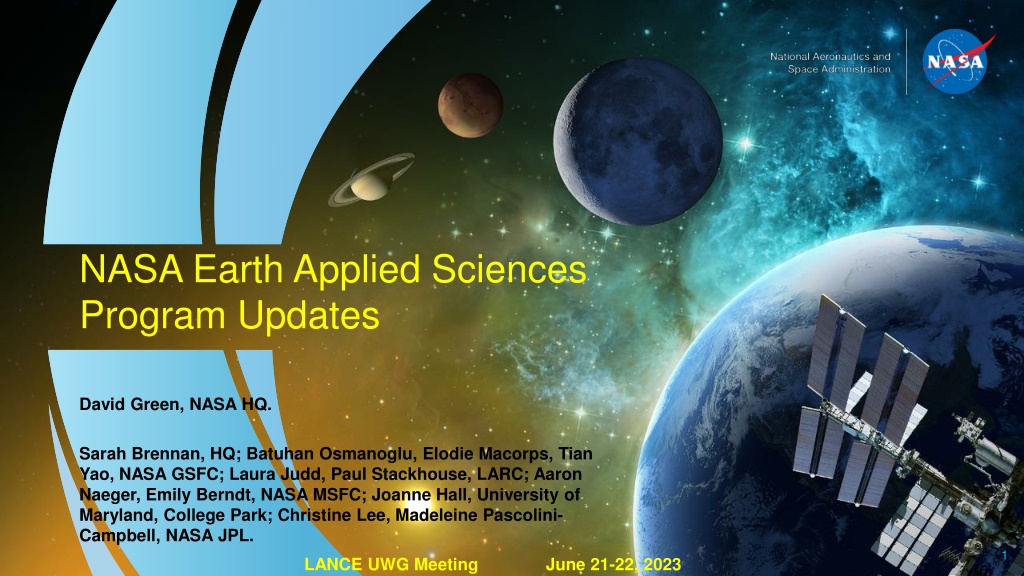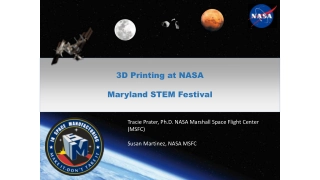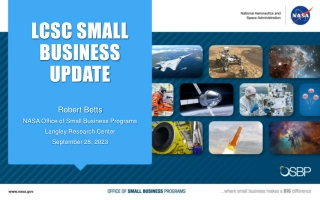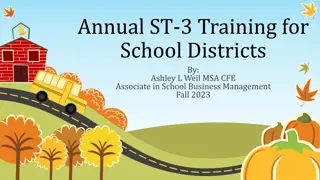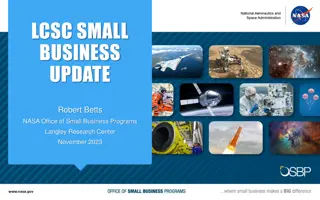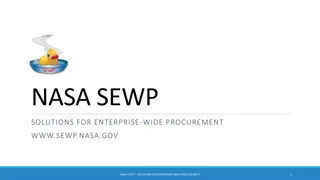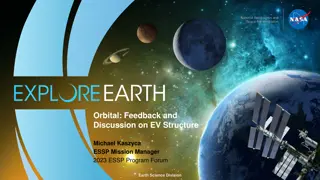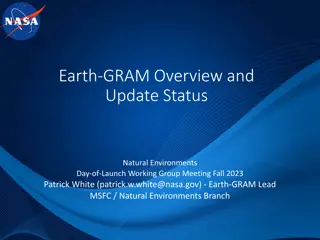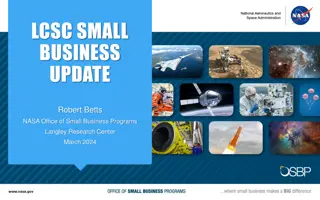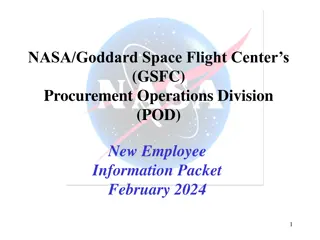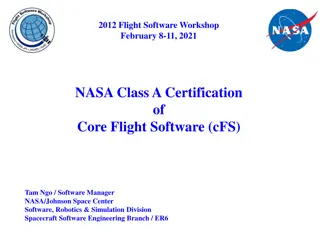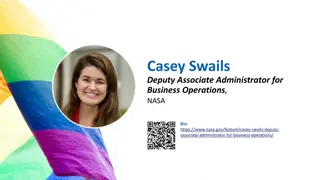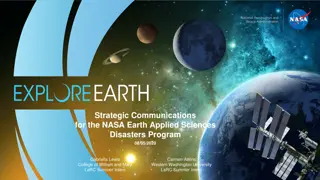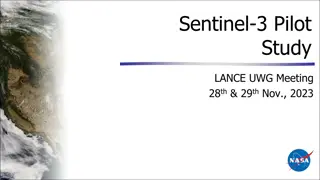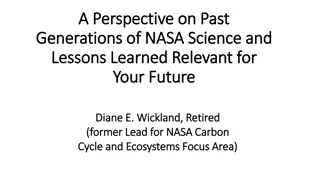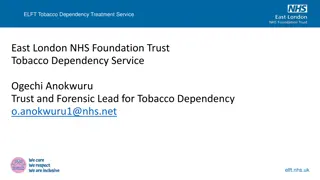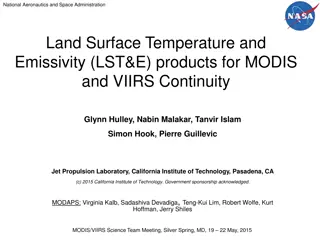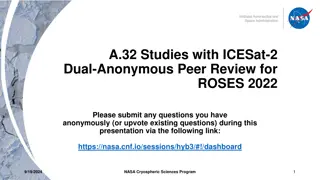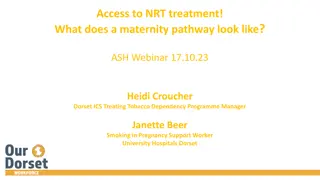NASA Earth Applied Sciences Program Updates and NRT Data Products
NASA's Earth Applied Sciences Program updates include discussions on NRT data products and user needs from health and air quality programs. Updates on NISAR, TEMPO, SBG, AOS, and LANCE are highlighted, focusing on real-time data products for monitoring various atmospheric parameters. Future near real-time data products like CALIPSO, TEMPO, and Sentinel5-P TROPOMI are also discussed, emphasizing the importance of high-temporal resolution data for pollution monitoring.
Download Presentation

Please find below an Image/Link to download the presentation.
The content on the website is provided AS IS for your information and personal use only. It may not be sold, licensed, or shared on other websites without obtaining consent from the author. Download presentation by click this link. If you encounter any issues during the download, it is possible that the publisher has removed the file from their server.
E N D
Presentation Transcript
NASA Earth Applied Sciences Program Updates David Green, NASA HQ. Sarah Brennan, HQ; Batuhan Osmanoglu, Elodie Macorps, Tian Yao, NASA GSFC; Laura Judd, Paul Stackhouse, LARC; Aaron Naeger, Emily Berndt, NASA MSFC; Joanne Hall, University of Maryland, College Park; Christine Lee, Madeleine Pascolini- Campbell, NASA JPL. 1 LANCE UWG Meeting June 21-22, 2023
Outline NRT Data Products and User Needs from ASP Updates from NISAR and TEMPO Updates from SBG and AOS 2
NRT Data Products and User Needs from Health & Air Quality Program Existing LANCE Near Real-time Data Products Relevant for Health & Air Quality Aerosols Trace Gases Other Aerosol Index (OMI/OMPS-NPP) Sulfur Dioxide (AIRS/MLS/OMI/OMPS-NPP) Imagery (MODIS/VIIRS) Aerosol Optical Depth (MODIS/OMI/VIIRS) Ozone (MLS/OMI/OMPS-NPP) Cloud (MODIS/VIIRS) Nitrous Oxide (MLS) Dust Score (AIRS) Temperature (MLS/MODIS/VIIRS) Dark Target Aerosol Optical Thickness (VIIRS/Suomi NPP) Nitric Acid (MLS) Fire Detection (MODIS/VIIRS/FIRMS) Albedo (MODIS/VIIRS) Carbon Monoxide (AIRS/MLS/MOPITT) Radiances (MODIS/VIIRS) Notes: Data products from OMI/MODIS/AIRS/MLS/AIRS/MOPITT instruments are onboard Terra/Aqua/Aura satellites. Non-LANCE NRT products include GOES-R AOD products from NOAA s AWS bucket and TROPOMI NO2 and L1B data and GPM Rainfall data and MODIS/VIIRS Radiances. MODIS Chlorophyll data (8 day) was also mentioned but I don t think that is NRT. 3
NRT Data Products and User Needs from Health & Air Quality Program Potential and Future Near Real-time Data Products Useful for Health & Air Quality Community CALIPSO (Cloud-Aerosol LIDAR and Infrared Pathfinder Satellite Observations): Currently the CALIPSO data products have a latency of 2-4 days. and probably will be less than 2 hours. TEMPO aerosol products of AOD, Aerosol Layer Height, UV Aerosol Index, SO2 and NO2 would help users to monitor pollutions with very high-temporal resolution. AOS (Atmosphere Observing System): The ALICAT lidar builds on the capability to provide NRT products and data products in Real Time using a Jetson TX2 GPU. TEMPO (Tropospheric Emissions: Monitoring of Pollution ): data products latency will be Near Real-time Sentinel5-P TROPOMI (Tropospheric Monitoring Instrument): Some people are using NRT products from the TROPOMI instrument but only the OFFL products are available through NASA earthdata search. They have to go to the S5P Data Hub for NRT but this can be subject to low download speeds and no ability to subset in time/space. The most important products for this would be NO2 and radiances as there are projects that actual put this to use currently but struggle with downloading via S5P. detection of land surface changes during cropland tilling (likely multi sensor). I am not sure a NRT algorithm exists for future implementation or whether it would need to be developed. Daniel Tong mentioned the need for a real-time dust detection product* (e.g., dust mask) including (Notes: For NRT Dust Detection product, Emily Berndt (NASA MSFC) provided the feedback that at SPoRT they have a NRT machine learning based dust identification product from GEOS data, called DustTracker-AI. This produce has been provided to National Weather Service.) 4
NRT Data Products and User Needs from Ecological Conservation Program Existing LANCE Data Products Relevant for Ecological Conservation Data_Products Satellite_Instruments MODIS/VIIRS MODIS/VIIRS VIIRS AIRS/MISR/MODIS/VIIRS AMSR2/SMAP MODIS/VIIRS MODIS/VIIRS MODIS Active Fire/Thermal Anomalies Albedo Black Marble Night-time Light Cloud Soil Moisture Surface Reflectance Surface Temperature Vegetation Index Future Needs of Data Capabilities: Forest management community need low latency land cover data within 24 hours, and thus they require access to low latency SAR products to reduce possible cloud contamination. Potential Data Products from Future EO Missions Surface Biology and Geology (SBG) 5 (Notes: Data products from OMI/MODIS/AIRS/MLS/AIRS/MOPITT instruments are onboard Terra/Aqua/Aura satellites.)
NRT Data Products and User Needs from NASA POWER Existing LANCE Data Products Relevant for Energy Data_Products Satellite_Instruments Aerosols and Trace Gases AIRS/MLS/MODIS/MOPITT/OMI/OMPS/VIIRS Cloud (for surface fluxes) AIRS/MODIS/VIIRS Satellite Radiances (for surface fluxes) AIRS/MODIS/VIIRS Soil Moisture AMSR2/SMAP Surface Precipitation AMSR2 Temperature (near surface, skin) AIRS/MLS/MODIS/VIIRS Water Vapor (near surface, column) AIRS/AMSR2/MLS/MODIS Wind Speed (10m, PBL profile) AMSR2/MISR (Notes: Data products from OMI/MODIS/AIRS/MLS/AIRS/MOPITT instruments are onboard Terra/Aqua/Aura satellites.) 6 6
NRT Data Products and User Needs from NASA POWER Identified gaps: Currently, without solar irradiance, the POWER team haven t been able to utilize/provide LANCE products. POWER provides the global gridded solar irradiance from CERES. Future Needs of Data Capabilities: projections/forecasts, and multi-year typical/extremes at an hourly scale. Users would like to see lower latency and higher resolution gridded data products, future Potential Data Products from Future EO Missions Monitoring of Pollution), PACE (Plankton, Aerosol, Cloud, ocean Ecosystem), Libera. SWOT (Surface Water and Ocean Topography), TEMPO (Tropospheric Emissions: (Source: 2022 POWER Global Community (GloCo) Summit Summary Report.) 7 7
NRT Data Products and User Needs from Water Resources Program Areas where Users May Benefit from NRT Data Products: Water quality indicators: For example, oil spills and harmful algal blooms. Water levels for transportation: For example, the Department of Transportation in Alaska need information of stream flow levels and water surface extent. Potential Data Products from Future EO Missions Surface Water and Ocean Topography (SWOT) was launched in December 2022. Plankton, Aerosol, Cloud, ocean Ecosystem (PACE): Planned launch date is January 2024. NASA-ISRO SAR Mission (NISAR): Planned launch date is January 2024. 8 8
Use Cases and Feedback on NRT Data Products from Applied Sciences Wildland Fires Program The majority of current low-latency needs within the Wildland Fires Program portfolio are associated with the Active Fire portion of the fire cycle: CAL FIRE command center ingests LANCE MODIS/VIIRS data to monitor fire behavior during an active fire incident. Technosylva s Wildfire Analyst software, which utilizes LANCE FIRMS active fire data, has been adopted within several projects, including the WRF-SFIRE system project. NRT fire detections used for modelling fire behavior, fire perimeters, and progression in several projects. Funded project focused on the direct broadcast (within 60 seconds) of ABI, MODIS & VIIRS active fire data through FIRMS. Funded project integrating low-latency Landsat-8/9 data into NASA FIRMS. Several examples of low-latency data are seen in our Post-Fire portfolio Funded project using lower latency data for rapid assessment of wildfire burn severity estimates for post-fire BAER teams. FIREDpy Incorporates a constellation of optional and SAR to reduce the latency in characterizing burned area. What potential new products or opportunities do you see in the near future related to near real-time data systems like LANCE? Near-real time VIIRS burned area. 9
Portfolio Example: Landsat active fire map (red dots) of Mosquito Fire on September 9, 2022. A University of Maryland team along with NASA, USDA Forest Service, and USGS have integrated 1) global, multi-platform geostationary active fire data in near-real-time, and 2) low-latency, high-resolution Landsat active fire data for North America into FIRMS US/Canada. NASA FIRMS has a large, extremely broad user base (researchers, land managers, land & homeowners, legal professionals, etc.).
NASA-ISRO SAR Mission (NISAR) NISAR is a joint Earth-observing mission between NASA and the Indian Space Research Organization (ISRO). Planned Launch Date: January 29, 2024 Instruments: L-band SAR (NASA) + S-band SAR (ISRO). Data Product Specifics: Global imaging twice (ascending and descending) every 12-days! 3-10 m-resolution (mode-dependent) Imaging capabilities independent of weather conditions From Raw (L0) and Calibrated (L1) to Analysis Ready Data L2 Products with geocoded and radiometrically terrain corrected amplitude images and interferograms Continuous, coherent, consistent time-series Data Latency for Urgent Response: 24-hour tasking, 5-hour data delivery (24/5). 11
NASA-ISRO SAR Mission (NISAR) Community of Practice (192 members) are individuals or organizations that can be public or private, Federal or local entities, and can have a local, national or international scope for their application. Early Adopters (190 Applications, 106 Members) use NISAR-like data for their applications and provide important feedback to the NISAR team regarding successes and limitations of NISAR products meeting their needs. Apply here: https://nisar.jpl.nasa.gov/engagement/application-sign-up Early Adopters Science Application Categories 12
Surface Biology and Geology (SBG) SBG is in the Pre-Phase A (Pre-Concept Study Phase). A target latency of 24 hours or less was determined to be ideal for applications which was incorporated into all SBG candidate architectures. Reference: "Christine M. Lee et al., Systematic Integration of Applications into the Surface Biology and Geology (SBG) Earth Mission Architecture Study, JGR Biogeosciences, 2022." 18
Source: Christine Lee's presentation in the 8th SBG Community Webinar.
Thank you! Many thanks to co-authors! 28
